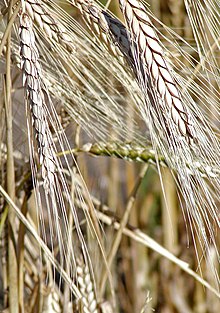Khorasan wheat
This article needs additional citations for verification. (December 2020) |
| Khorasan wheat | |
|---|---|

| |
| Scientific classification | |
| Kingdom: | Plantae |
| Clade: | Tracheophytes |
| Clade: | Angiosperms |
| Clade: | Monocots |
| Clade: | Commelinids |
| Order: | Poales |
| Family: | Poaceae |
| Subfamily: | Pooideae |
| Genus: | Triticum |
| Species: | T. turanicum
|
| Binomial name | |
| Triticum turanicum | |
| Synonyms[1] | |

Khorasan wheat or Oriental wheat (Triticum turgidum ssp. turanicum also called Triticum turanicum) is a
, and has a rich, nutty flavor.Taxonomy
Original botanical identifications were uncertain. The variety is a form of Triticum turgidum subsp. turanicum (also known as Triticum turanicum), usually called
Life form
As an
Yield
The actual average yield of Khorasan wheat is 1.1–1.3 tonnes per hectare (980–1,160 pounds per acre).[citation needed] In drier years, Khorasan wheat can sometimes yield even more than durum wheat.[citation needed] However, in normal or wet years, it yields approximately 1/3 less than the durum wheat.
Distribution
With only 6,500 hectares (16,000 acres) cultivated worldwide, Khorasan wheat does not play an important role in the world food system. By capturing this niche market, Khorasan wheat counterbalances its weak agronomic traits.[6]
Product use
Khorasan wheat is used similarly as modern wheat. Its grains can be consumed whole, or milled into flour. It can be found in breads, bread mixes, breakfast cereals, cookies, waffles, pancakes, bulgur, baked goods, pastas, drinks, beer, and snacks.
Apart from its nutritional qualities, Khorasan wheat is recognized for its smooth texture and nutty, buttery flavor.[4]
Nutrition and composition
Nutrients
| Nutritional value per 100 g (3.5 oz) | |
|---|---|
| Energy | 1,411 kJ (337 kcal) |
70.38 g | |
| Starch | 52.41 g |
| Dietary fiber | 9.1 g |
2.2 g | |
| Saturated | 0.192 g |
| Monounsaturated | 0.214 g |
| Polyunsaturated | 0.616 g |
14.7 g | |
Niacin (B3) | 40% 6.35 mg |
| Pantothenic acid (B5) | 18% 0.9 mg |
| Vitamin B6 | 15% 0.255 mg |
| Vitamin E | 4% 0.6 mg |
| Minerals | Quantity %DV† |
| Iron | 25% 4.41 mg |
| Magnesium | 32% 134 mg |
| Manganese | 124% 2.86 mg |
| Phosphorus | 31% 386 mg |
| Potassium | 15% 446 mg |
| Zinc | 33% 3.68 mg |
| Other constituents | Quantity |
| Water | 10.95 g |
| †Percentages estimated using US recommendations for adults,[7] except for potassium, which is estimated based on expert recommendation from the National Academies.[8] | |
In a 100-gram (3+1⁄2-ounce) reference serving, Khorasan wheat provides 1,410 kilojoules (337 kilocalories) of
Composition
Khorasan wheat has high protein content which improves its vitreousness[9] which indicates a high milling yield.[4]
Gluten
As khorasan wheat contains
Requirements for climate and soil
A temperate continental climate with cold nights in the early spring (see
Khorasan wheat is especially known for its drought tolerance, which is even better than that of durum wheat. Too much precipitation, especially in the end of the season, usually leads to dramatic disease problems (see section below).
Soils typically used for Khorasan wheat are the same as for durum wheat: deep friable black clays with a certain water storing capacity, also known as
Cultivation
The cultivation practices are quite similar to other wheat species, especially durum. As most of the Khorasan wheat is organically produced, the
Harvest in general follows the same procedure as in the other wheat species. As soon as the grains are mature, a combine harvester threshes the Khorasan wheat. But contrary to common wheat, the seeds of Khorasan wheat are very brittle and crack in half very easily, which leads to a necessarily more gentle harvest and post-harvest treatment.
Diseases
The range of diseases in Khorasan wheat is more or less the same as in all other wheat species. Main diseases are typically caused by
Because of the high susceptibility to fungi, crop rotation is quite important, especially under organic production conditions. The rotation requirements resemble more or less those of durum wheat.
Aspects of breeding
The traditional aim of
See also
References
- ^ "The Plant List: A Working List of All Plant Species".
- ^ .
- S2CID 86510231.
- ^ .
- ^ Quinn, R.M (1999). "Kamut: Ancient grain, new cereal". In Janick, J. Perspectives on new crops and new uses. Alexandria: ASHS Press. pp. 182–183.
- ^ a b Singh, Av (Winter 2007). "Ancient Grains, a wheat by any other name". The Canadian Organic Grower.
- ^ United States Food and Drug Administration (2024). "Daily Value on the Nutrition and Supplement Facts Labels". Retrieved 2024-03-28.
- )
- ^ El-Rassas, H.N.; Atwa, M.F.; Mostafa, K.M. (1989). "Studies on the effect of gamma rays on the technological characteristics of some Egyptian wheat varieties". Faculty Journal of Agricultural Research Development. 3 (1): 1–21.
- PMID 25789300.
- ^ a b c Kneipp J. (2008), Durum wheat production, State of New South Wales through NSW Department of Primary Industries - Tamworth Agricultural Institute, Calala
Further reading
- Sacks, Gordon (2005). "Kamut: A New Old Grain". Gastronomica. 5 (4): 95–98. JSTOR 10.1525/gfc.2005.5.4.95.
- Quinn, R.M. (1999). "Kamut: Ancient grain, new cereal". In Janick, J. (ed.). Perspectives on new crops and new uses. ASHS Press, Alexandria. pp. 182–183.
- Rodríguez-Quijano, Marta; Lucas, Regina; Ruiz, Magdalena; Giraldo, Patricia; Espí, Araceli; Carrillo, José M. (2010). "Allelic Variation and Geographical Patterns of Prolamins in the USDA-ARS Khorasan Wheat Germplasm Collection". Crop Science. 50 (6): 2383–91. .

